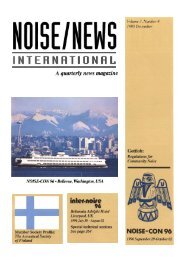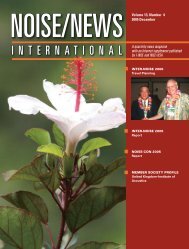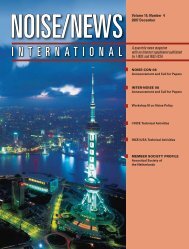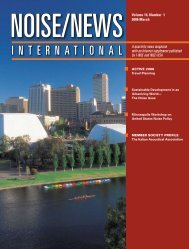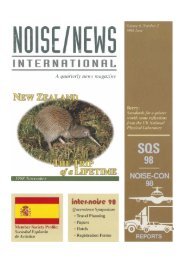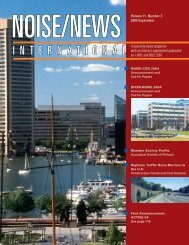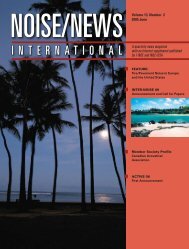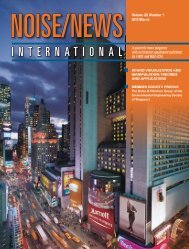Volume 6, Number 4, December, 1998 - Noise News International
Volume 6, Number 4, December, 1998 - Noise News International
Volume 6, Number 4, December, 1998 - Noise News International
Create successful ePaper yourself
Turn your PDF publications into a flip-book with our unique Google optimized e-Paper software.
specify in more detail relevant measurement<br />
methods, application-related assessment criteria,<br />
and design measures.<br />
Framework Standards and Safety<br />
Standards Specific to Machinery<br />
The framework standards (A or B standards) that<br />
have been developed for machinery safety - EN<br />
292-l 6 and EN 292-2,6 and EN 414 7 - specify<br />
principles for detecting and avoiding hazards and<br />
for increasing machinery safety. With regard to<br />
acoustics, there are framework standards (B standards)<br />
for determination of sound emission and for<br />
an explanation of principles of noise reduction of<br />
machines and the implementation of those principles:<br />
EN ISO 3740 ff,8 EN ISO 11200 ff,9 EN ISO<br />
4871,10 EN ISO 12001,11 EN ISO 11688,12 EN<br />
ISO 11689,13 EN ISO 11690. 14 The machine<br />
safely standards and an explanation of their purpose<br />
are given in Table 2.<br />
Appropriate safety standards (C standards) are<br />
prepared in support of the ED machinery directive<br />
for different groups of machines based on the framework<br />
standards. According to EN 414, these framework<br />
safety standards should contain:<br />
Type A<br />
Table 2: Machine safety standards: noise control<br />
Framework standards: basic principles<br />
EN 292, EN 414<br />
Type B Framework standards: individual hazards<br />
Sound emission<br />
• Measurement<br />
- Guide<br />
- Sound power Level<br />
- Emission sound pressure level<br />
- Declaration and verification<br />
• Reduction<br />
• Value ranges<br />
EN ISO 12001<br />
EN ISO 3740 to 47,<br />
9614<br />
EN ISO 11200 to 04<br />
EN ISO 4871<br />
EN ISO 11688-1<br />
EN ISO 11689<br />
Safety standards<br />
<strong>Noise</strong> emission<br />
specific to machinery<br />
test codes<br />
Dealing with the hazard of noise according to EN 1746<br />
• Safety requirements<br />
• noise<br />
- noise reduction<br />
• Checking safety requirements<br />
• noise<br />
- sound measurement<br />
- emission value range<br />
- achievable value<br />
• Information for the machine user<br />
• noise<br />
- noise data, noise measurement<br />
- additional noise reduction measures<br />
Example:<br />
EN 691 wood working machines<br />
ISO 7960<br />
EN 710 foundry machines<br />
EN 1265.<br />
• A description of the hazards concerned,<br />
• the safety objectives to be achieved,<br />
• the safety requirements and/or measures for reducing<br />
hazards,<br />
• the test methods which can be used to establish<br />
compliance with the safety requirements contained<br />
in the standard, and<br />
• user information.<br />
These machine-specific safety standards therefore<br />
have an important practical role: they are the means<br />
by which the noise control requirements of the machinery<br />
directive are to be specified.<br />
Standards EN 414 and EN 292-1 describe a series<br />
of noise hazards leading to, for example, hearing<br />
loss, tinnitus, stress and impairment of verbal communication.<br />
If significant hazards of this kind are<br />
caused by a machine, noise must be taken into account<br />
in the development of the safety standard specific<br />
to that type of machine. In general, this is<br />
necessary if a machine is associated with an emission<br />
sound pressure level of LpA =70 dB or more.<br />
Draft standard EN 1746 15 prescribes the necessary<br />
provisions on noise which should be included in such<br />
machine-specific, general safety standards. According<br />
to this draft standard, where a noise hazard may exist, a<br />
machine-specific safety standard should:<br />
• Classify noise in the list of hazards,<br />
• name the machine's main noise sources,<br />
• refer to principles of low-noise design<br />
(according to ISO TR 11688-1), give<br />
concrete examples of noise control by<br />
design, describe the use of sound insulation<br />
products (enclosures, etc.), and emphasize<br />
the importance of sound<br />
emission level as the main criterion for<br />
selection of low-noise machines,<br />
• emphasize the importance of determining<br />
noise emission levels to facilitate monitoring<br />
of the machine design process,<br />
• compile machine emission value ranges<br />
for one machine type (to EN ISO 11689)<br />
and deduce attainable values if possible,<br />
• develop the information necessary for user<br />
instructions (to EN ISO 11690-1 and -2)<br />
so as to allow for low-noise operation, e.g.,<br />
installation of dampers, adaptation to<br />
low-noise operating conditions, maintenance<br />
to ensure low-noise operation, and<br />
recommendation of additional equipment<br />
(enclosures, noise screens and, if necessary,<br />
hearing protectors), and<br />
• specify noise data for user instructions and<br />
technical documents.<br />
If there is no significant hazard caused by<br />
noise for a group of machines, then the section<br />
on noise can be limited. However, it must at<br />
<strong>1998</strong> <strong>December</strong> <strong>Noise</strong>l<strong>News</strong> <strong>International</strong> 203



